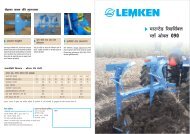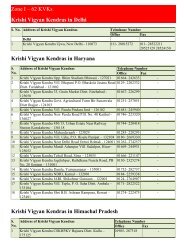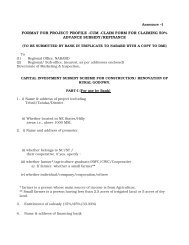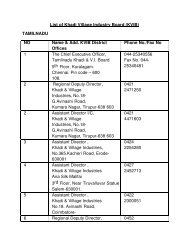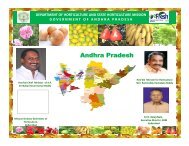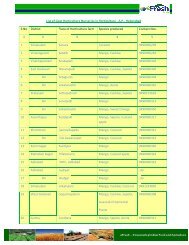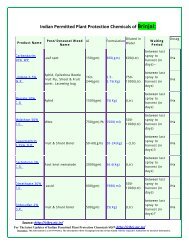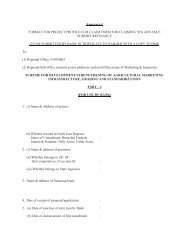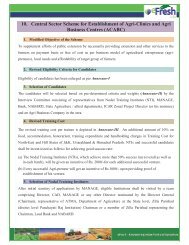Zero tillage technology on Maize - Efresh India
Zero tillage technology on Maize - Efresh India
Zero tillage technology on Maize - Efresh India
You also want an ePaper? Increase the reach of your titles
YUMPU automatically turns print PDFs into web optimized ePapers that Google loves.
<str<strong>on</strong>g>Zero</str<strong>on</strong>g> <str<strong>on</strong>g>tillage</str<strong>on</strong>g> <str<strong>on</strong>g>technology</str<strong>on</strong>g> <strong>on</strong> <strong>Maize</strong><br />
Good Agricultural practice (GAP) activities<br />
have been organized at Gangupally and<br />
Kandlapally villages. A field day <strong>on</strong> zero<br />
<str<strong>on</strong>g>tillage</str<strong>on</strong>g> maize in rice fallows c<strong>on</strong>ducted during<br />
Feb 2012 and March 2013. Dr G Nirmala, PI<br />
and senior scientist of CRIDA of the GAP<br />
project discussed with women farmers of the<br />
various benefits of zero <str<strong>on</strong>g>tillage</str<strong>on</strong>g>. C<strong>on</strong>cepts,<br />
benefits and profitability of zero <str<strong>on</strong>g>tillage</str<strong>on</strong>g> were<br />
explained to farm women which are as<br />
follows: About zero <str<strong>on</strong>g>tillage</str<strong>on</strong>g> <str<strong>on</strong>g>technology</str<strong>on</strong>g> –<br />
What is <str<strong>on</strong>g>Zero</str<strong>on</strong>g> <str<strong>on</strong>g>tillage</str<strong>on</strong>g> <str<strong>on</strong>g>technology</str<strong>on</strong>g>?<br />
<str<strong>on</strong>g>Zero</str<strong>on</strong>g>- <str<strong>on</strong>g>tillage</str<strong>on</strong>g>, syn<strong>on</strong>ymous to no-<str<strong>on</strong>g>tillage</str<strong>on</strong>g> or c<strong>on</strong>servati<strong>on</strong> agriculture is worldwide accepted<br />
and adopted <strong>on</strong> 115m.ha of cultivated land. South America ranks first in acreage accounting to<br />
49.5 m.ha with nearly 70 percent of land go under no- <str<strong>on</strong>g>tillage</str<strong>on</strong>g> cultivati<strong>on</strong>. <str<strong>on</strong>g>Zero</str<strong>on</strong>g> <str<strong>on</strong>g>tillage</str<strong>on</strong>g> <str<strong>on</strong>g>technology</str<strong>on</strong>g><br />
was first reported in USA in 1930’s and from there spread to many countries of Europe,<br />
Australia, Canada, Asia and Africa.<br />
Benefits from <str<strong>on</strong>g>Zero</str<strong>on</strong>g> <str<strong>on</strong>g>tillage</str<strong>on</strong>g>:<br />
No-till farming addresses many global challenges of climate change, soil degradati<strong>on</strong> and food<br />
security. Benefits derived are therefore to be taken seriously by practicing farmers, researchers<br />
and development professi<strong>on</strong>al. AAPRESID, 2008 reported benefits of no-<str<strong>on</strong>g>tillage</str<strong>on</strong>g> systems are<br />
follows.<br />
• 96% less erosi<strong>on</strong><br />
• 66% reducti<strong>on</strong> in fuel c<strong>on</strong>sumpti<strong>on</strong><br />
• Reduced CO 2 emissi<strong>on</strong>s<br />
• Enhanced water quality<br />
• Higher biological activity<br />
• Increased soil fertility<br />
• Enhanced producti<strong>on</strong> stability and<br />
yields<br />
• Incorporati<strong>on</strong> of new areas into<br />
producti<strong>on</strong><br />
• Lower producti<strong>on</strong>s costs.<br />
1
Myths <strong>on</strong> <str<strong>on</strong>g>Zero</str<strong>on</strong>g> <str<strong>on</strong>g>tillage</str<strong>on</strong>g> c<strong>on</strong>cept:<br />
Adopti<strong>on</strong> rates of zero <str<strong>on</strong>g>tillage</str<strong>on</strong>g> are small, mainly arising from lack of clarity with regard to<br />
the c<strong>on</strong>cept of <str<strong>on</strong>g>Zero</str<strong>on</strong>g> <str<strong>on</strong>g>tillage</str<strong>on</strong>g>, as many c<strong>on</strong>sider it to be a <str<strong>on</strong>g>technology</str<strong>on</strong>g> of placing seed in untilled soil<br />
and other aspects of its c<strong>on</strong>tinuity, crop residue management are not much given emphasis. As a<br />
c<strong>on</strong>sequence, possibilities of realizing full benefits from no-<str<strong>on</strong>g>tillage</str<strong>on</strong>g> are meager. In real terms<br />
zero-<str<strong>on</strong>g>tillage</str<strong>on</strong>g> is c<strong>on</strong>sidered 50 percent of C<strong>on</strong>servati<strong>on</strong> agriculture which mainly focuses <strong>on</strong> three<br />
major principles (FAO, 2009).as given below.<br />
1. C<strong>on</strong>tinuous minimum mechanical soil<br />
2. Permanent organic soil cover.<br />
3. Diversified crop rotati<strong>on</strong>s.<br />
The widely accepted definiti<strong>on</strong> of Philips and Young (1978) <strong>on</strong> no-<str<strong>on</strong>g>tillage</str<strong>on</strong>g> reflects all the<br />
comp<strong>on</strong>ents that qualify for c<strong>on</strong>servati<strong>on</strong> agriculture.<br />
“ No- <str<strong>on</strong>g>tillage</str<strong>on</strong>g> is defined as system of planting (seeding)crops into untilled soil by<br />
opening a narrow slot, trench or band <strong>on</strong>ly of sufficient width and depth to obtain proper<br />
seed coverage. No other soil <str<strong>on</strong>g>tillage</str<strong>on</strong>g> is d<strong>on</strong>e.”<br />
Practicing no-<str<strong>on</strong>g>tillage</str<strong>on</strong>g> <str<strong>on</strong>g>technology</str<strong>on</strong>g> strictly means, the soil need be permanently covered with crop<br />
residues of previous crop or management with green manure cover crops and subsequently<br />
ensuring crop rotati<strong>on</strong>s.<br />
Adopti<strong>on</strong> of <str<strong>on</strong>g>Zero</str<strong>on</strong>g> <str<strong>on</strong>g>tillage</str<strong>on</strong>g> <str<strong>on</strong>g>technology</str<strong>on</strong>g> in <strong>India</strong>:<br />
The adopti<strong>on</strong> of zero-<str<strong>on</strong>g>tillage</str<strong>on</strong>g> practices by farmers has occurred mainly in rice-wheat double<br />
cropping systems primarily to avoid late planting of wheat.<br />
For cultivati<strong>on</strong> of rice in next seas<strong>on</strong> farmers carry out <str<strong>on</strong>g>tillage</str<strong>on</strong>g> operati<strong>on</strong>s such as ploughing and<br />
puddling of soil. This makes no- <str<strong>on</strong>g>tillage</str<strong>on</strong>g> wheat a temporary practice rather a c<strong>on</strong>tinuous <strong>on</strong>e. The<br />
area under such temporary no-<str<strong>on</strong>g>tillage</str<strong>on</strong>g> practice accounts to 5 m.ha., unfortunately has been<br />
counted out from inclusi<strong>on</strong> under no-<str<strong>on</strong>g>tillage</str<strong>on</strong>g> practice There are very few farmers practicing zero<br />
<str<strong>on</strong>g>tillage</str<strong>on</strong>g> <str<strong>on</strong>g>technology</str<strong>on</strong>g> in its true sense.<br />
<strong>Maize</strong> crop has been cultivated in Andhra Pradesh since 1999. Since then acreage over a<br />
decade period from 1999 to 2009 had increased from 3.60 lakh acres to 5.30 lakh acres in kharif,<br />
0.92 lakh acres to 3.58 lakh acres in Rabi. The productivity of the crop varied between 2205 kgs<br />
per ha to 4581 kgs per ha depending <strong>on</strong> the availability of moisture and favorable c<strong>on</strong>diti<strong>on</strong>s<br />
during kharif. In Rabi crop, maize crop cultivated under irrigated c<strong>on</strong>diti<strong>on</strong>s produced yield<br />
ranging between 2996 kgs per ha to 4930 kgs per ha.<br />
2
FARMERS PERCEPTIONS ON VARIOUS FACTORS OF PRODUCTION.<br />
“Is it possible to cultivate a crop without<br />
ploughing and opening up of soil?” This was<br />
the first reacti<strong>on</strong> of farmers <strong>on</strong> hearing about the<br />
zero till <str<strong>on</strong>g>technology</str<strong>on</strong>g>. It was obvious that the<br />
whole village was unaware of such <str<strong>on</strong>g>technology</str<strong>on</strong>g><br />
making dem<strong>on</strong>strati<strong>on</strong> itself very novel in nature.<br />
Farmers were skeptical of results till the end of<br />
dem<strong>on</strong>strati<strong>on</strong>.<br />
A dem<strong>on</strong>strati<strong>on</strong> was laid out in rice<br />
fallows of red soils. Sowing was taken up during<br />
first week of December using seed marker possessing pegs at distance of 30 cms. Women family<br />
labour worked <strong>on</strong> seed marker for placing seed and fertilizers in adjacent holes made by drill.<br />
Pre–emergence weedicides were sprayed to c<strong>on</strong>trol weeds that might arise from rice stubbles.<br />
Other regular management practices such as top dressing, plant protecti<strong>on</strong> were similar as in<br />
c<strong>on</strong>venti<strong>on</strong>ally tilled crop. A field day was c<strong>on</strong>ducted to upscale the <str<strong>on</strong>g>technology</str<strong>on</strong>g> and gather<br />
feedback from farmers before the harvest of crop. Farmers percepti<strong>on</strong>s were drawn <strong>on</strong> different<br />
factors such as <str<strong>on</strong>g>tillage</str<strong>on</strong>g> cost, yields, Nett returns, weed management and nutrient and pest<br />
management aspects.<br />
Tillage cost: Farmers assessed savings <strong>on</strong> cost of <str<strong>on</strong>g>tillage</str<strong>on</strong>g> operati<strong>on</strong>s in comparis<strong>on</strong> to<br />
c<strong>on</strong>venti<strong>on</strong>al practice, as rice fallows possess hard sub surface soil <strong>on</strong> account of flooding of<br />
previous seas<strong>on</strong> crop. Minimum of 6 ploughings required to break hard clods amounting to cost<br />
escalati<strong>on</strong> to the tune of Rs 6000 per acre in c<strong>on</strong>venti<strong>on</strong>al <str<strong>on</strong>g>tillage</str<strong>on</strong>g>. This was found to have reduced<br />
in zero till crop. In this <str<strong>on</strong>g>technology</str<strong>on</strong>g> the field usually not ploughed and soil is opened up for<br />
sowing with seed drill and fertilizer is placed in adjacent slot made with same seed drill. A seed<br />
drill specially designed for the purpose actually facilitated in sowing which to a large extent<br />
c<strong>on</strong>stituted the success factor of <str<strong>on</strong>g>technology</str<strong>on</strong>g> adopti<strong>on</strong>.<br />
Labour use: Only family labour was utilized throughout all farm operati<strong>on</strong>s and incurred less of<br />
labour cost compared to c<strong>on</strong>venti<strong>on</strong>al <str<strong>on</strong>g>tillage</str<strong>on</strong>g> method. But farmer reported high family labour that<br />
has been utilized for c<strong>on</strong>tinuous m<strong>on</strong>itoring of crop as night watchman, irrespective of ZT or CT<br />
maize, against wild boar causing severe damage particularly after sowing and cob development<br />
stages. 60 percent of durati<strong>on</strong> of crop c<strong>on</strong>sumed family labour <strong>on</strong>ly to guard at nights to prevent<br />
from wild boars attack.<br />
Weed Management: As major thrust in <str<strong>on</strong>g>Zero</str<strong>on</strong>g> <str<strong>on</strong>g>tillage</str<strong>on</strong>g> is weed management its c<strong>on</strong>trol, therefore,<br />
c<strong>on</strong>sumed high proporti<strong>on</strong> of weedicides. 15 percent of cost of inputs was incurred <strong>on</strong><br />
3
weedicides mainly to c<strong>on</strong>trol weeds and prevent rice stubbles emergence. Zenteir and Campbell<br />
(1998) reported, zero <str<strong>on</strong>g>tillage</str<strong>on</strong>g> found successful <strong>on</strong>ly when weedicides prices are low in order to<br />
improve use efficiency. However, inspite of high Nett returns from ZT, envir<strong>on</strong>ment c<strong>on</strong>cerns<br />
need to be given top priority as chances of c<strong>on</strong>taminati<strong>on</strong> of ground water from atrazine sprays<br />
cause severe envir<strong>on</strong>mental hazards and therefore a well planned integrated weed c<strong>on</strong>trol<br />
measures to be adopted.<br />
Nutrient management: Many micr<strong>on</strong>utrient deficiencies were identified by farmers during crop<br />
growth stage and had to be corrected by series of foliar sprays with N,K and Zn. Corrective<br />
measures incurred 35 percent of total cost <strong>on</strong> inputs. Nitrogen in the form of urea was applied<br />
more in ZT crop .This was is in agreement with Grover and Sharma, 2011, who reported higher<br />
urea applicati<strong>on</strong> in zero tilled wheat crop.<br />
In zero <str<strong>on</strong>g>tillage</str<strong>on</strong>g> <str<strong>on</strong>g>technology</str<strong>on</strong>g>, fertilizer applicati<strong>on</strong> is challenging and therefore to derive<br />
complete benefit of <str<strong>on</strong>g>Zero</str<strong>on</strong>g> <str<strong>on</strong>g>tillage</str<strong>on</strong>g> with <strong>Maize</strong> crop, a high nutrient feeder, there is need to improve<br />
input use efficiency by adopti<strong>on</strong> of soil test based fertilizer applicati<strong>on</strong>, timely foliar sprays with<br />
micr<strong>on</strong>utrients and proper placement of fertilizers.<br />
Nett returns: <str<strong>on</strong>g>Zero</str<strong>on</strong>g> <str<strong>on</strong>g>tillage</str<strong>on</strong>g> rabi maize resulted in 60 percent higher Nett returns when compared<br />
to C<strong>on</strong>venti<strong>on</strong>al <str<strong>on</strong>g>tillage</str<strong>on</strong>g> grown rabi maize. Studies reported variability in Nett returns from high<br />
to low depending to cost of inputs and variati<strong>on</strong>s in crop yields (Khakbazan and Hamilt<strong>on</strong>, 2012)<br />
Yields: Farmers did not find any significant change in yield levels under two technologies of<br />
ZT and CT technologies. Yield increase is subjective in nature as farmers with 1-2 quintal gain is<br />
not big deal from farmers point of view. This <str<strong>on</strong>g>technology</str<strong>on</strong>g> has not dem<strong>on</strong>strated much yield<br />
increase but gains in Nett returns by reducti<strong>on</strong> of <str<strong>on</strong>g>tillage</str<strong>on</strong>g> cost to the tune of Rs 6000 form<br />
attractive propositi<strong>on</strong> to adopt this <str<strong>on</strong>g>technology</str<strong>on</strong>g> in future.<br />
Fodder security: It has provided ‘fodder security” to many livestock holding farmers that<br />
supplied adequate dry fodder for animals in summer.<br />
Local factors influence ec<strong>on</strong>omic performance of zero <str<strong>on</strong>g>tillage</str<strong>on</strong>g> maize as farmers adopt<br />
technologies from profitability point of view in terms of Nett returns and labour use, in c<strong>on</strong>trast<br />
to c<strong>on</strong>servati<strong>on</strong>ist view who look at sustainability of natural resources. However, c<strong>on</strong>sidering the<br />
resource c<strong>on</strong>servati<strong>on</strong> and increasing cost of cultivati<strong>on</strong> <str<strong>on</strong>g>Zero</str<strong>on</strong>g> <str<strong>on</strong>g>tillage</str<strong>on</strong>g> has been c<strong>on</strong>sidered as a<br />
promising <str<strong>on</strong>g>technology</str<strong>on</strong>g> to c<strong>on</strong>serve resources of soil, water and crop residues. In additi<strong>on</strong> to, the<br />
benefits derived from saving of <str<strong>on</strong>g>tillage</str<strong>on</strong>g> time and cost, availability of seed drill for sowing and<br />
fertilizer placement are important factors essential for up scaling of zero <str<strong>on</strong>g>technology</str<strong>on</strong>g>.<br />
4




